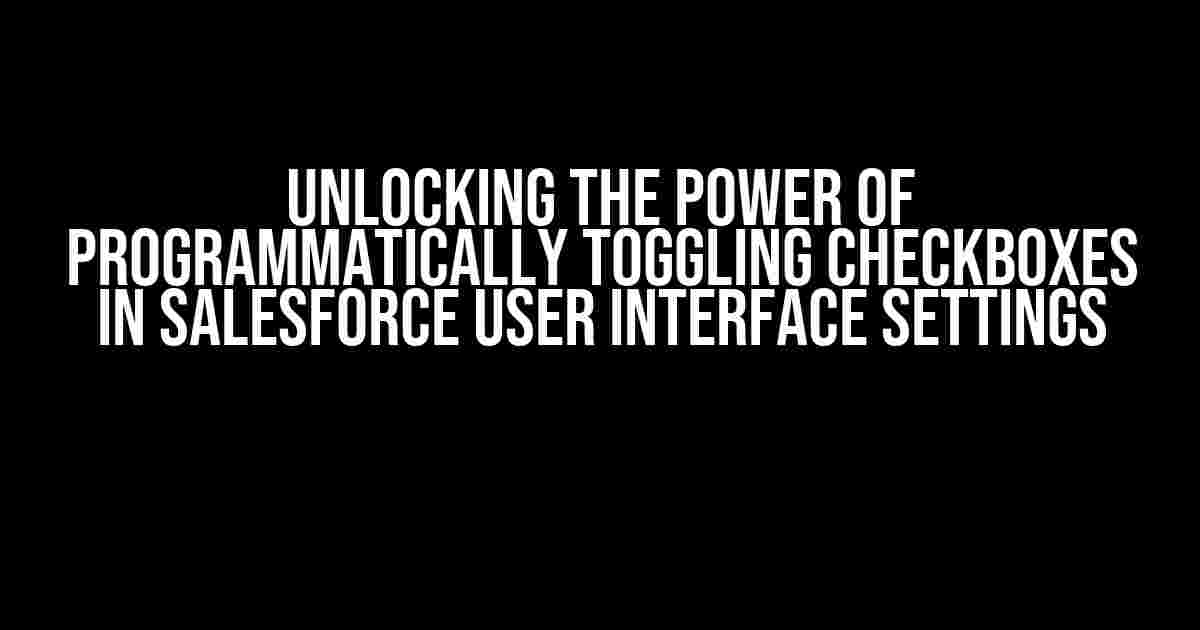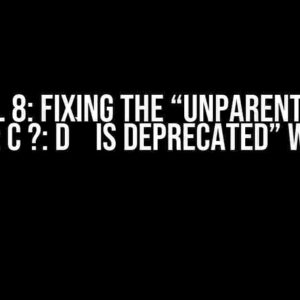Are you tired of manually clicking through checkboxes in Salesforce user interface settings? Do you wish there was a way to automate this process and free up more time for the important stuff? Well, you’re in luck! In this article, we’ll explore how to programmatically toggle checkboxes in Salesforce user interface settings using various programming languages and techniques. Buckle up and get ready to take your Salesforce skills to the next level!
Why Toggle Checkboxes Programmatically?
Before we dive into the nitty-gritty, let’s talk about why toggling checkboxes programmatically is a game-changer. Here are a few reasons why:
- Efficiency**: Manually toggling checkboxes can be a tedious and time-consuming task, especially when dealing with large datasets. By automating this process, you can save hours of time and focus on more strategic initiatives.
- Consistency**: When you toggle checkboxes manually, there’s always a chance of human error. By using code, you can ensure consistency and accuracy in your checkbox settings.
- Scalability**: As your organization grows, so does the complexity of your Salesforce implementation. Programmatically toggling checkboxes allows you to scale your operations more easily and efficiently.
Prerequisites and Tools
Before we begin, make sure you have the following tools and skills:
- Salesforce Developer Account**: You’ll need a Salesforce developer account to access the necessary APIs and tools.
- Programming Language**: You can use any programming language that supports RESTful APIs, such as Java, Python, or Apex.
- Salesforce REST API**: Familiarize yourself with the Salesforce REST API, which allows you to interact with Salesforce data and metadata.
- API Explorer**: Use the API Explorer tool to explore and test Salesforce APIs.
Toggling Checkboxes using Apex
Let’s start with Apex, Salesforce’s proprietary programming language. We’ll use Apex to toggle checkboxes programmatically using the Salesforce REST API.
// Define the checkbox field and its API name
String checkboxField = 'My_Checkbox_Field__c';
String checkboxApiName = checkboxField.replace('_', '__');
// Define the record ID and the checkbox value
Id recordId = '001d300000000001';
Boolean checkboxValue = true;
// Update the checkbox field using the REST API
HttpRequest request = new HttpRequest();
request.setEndpoint(Url.valueOf('/services/data/v43.0/sobjects/Account/' + recordId + '/' + checkboxApiName));
request.setMethod('PATCH');
request.setBody(JSON.serialize(checkboxValue));
request.setHeader('Authorization', 'Bearer ' + accessToken);
request.setHeader('Content-Type', 'application/json');
// Execute the request and handle the response
Http http = new Http();
HttpResponse response = http.send(request);
if (response.getStatusCode() == 204) {
System.debug('Checkbox toggled successfully!');
} else {
System.debug('Error toggling checkbox: ' + response.getBody());
}
Toggling Checkboxes using Python
Next, let’s explore how to toggle checkboxes using Python and the Requests library.
import requests
import json
# Define the checkbox field and its API name
checkbox_field = 'My_Checkbox_Field__c'
checkbox_api_name = checkbox_field.replace('_', '__')
# Define the record ID and the checkbox value
record_id = '001d300000000001'
checkbox_value = True
# Set up the API endpoint and authentication
instance_url = 'https://your-domain.my.salesforce.com'
access_token = 'your_access_token'
headers = {
'Authorization': 'Bearer ' + access_token,
'Content-Type': 'application/json'
}
# Update the checkbox field using the REST API
url = f'{instance_url}/services/data/v43.0/sobjects/Account/{record_id}/{checkbox_api_name}'
response = requests.patch(url, headers=headers, json={'value': checkbox_value})
if response.status_code == 204:
print('Checkbox toggled successfully!')
else:
print('Error toggling checkbox:', response.text)
Toggling Checkboxes using Java
Finally, let’s explore how to toggle checkboxes using Java and the OkHttp library.
import okhttp3.OkHttpClient;
import okhttp3.Request;
import okhttp3.RequestBody;
import okhttp3.Response;
// Define the checkbox field and its API name
String checkboxField = "My_Checkbox_Field__c";
String checkboxApiName = checkboxField.replace("_", "__");
// Define the record ID and the checkbox value
String recordId = "001d300000000001";
Boolean checkboxValue = true;
// Set up the API endpoint and authentication
String instanceUrl = "https://your-domain.my.salesforce.com";
String accessToken = "your_access_token";
OkHttpClient client = new OkHttpClient();
Request request = new Request.Builder()
.url(instanceUrl + "/services/data/v43.0/sobjects/Account/" + recordId + "/" + checkboxApiName)
.patch(RequestBody.create(MediaType.get("application/json"), "{\"value\": " + checkboxValue + "}"))
.header("Authorization", "Bearer " + accessToken)
.header("Content-Type", "application/json")
.build();
// Execute the request and handle the response
Response response = client.newCall(request).execute();
if (response.code() == 204) {
System.out.println("Checkbox toggled successfully!");
} else {
System.out.println("Error toggling checkbox: " + response.body().string());
}
Common Errors and Troubleshooting
When toggling checkboxes programmatically, you may encounter some common errors. Here are a few troubleshooting tips to help you overcome these issues:
| Error | Cause | Solution |
|---|---|---|
| 403 Forbidden | Invalid access token or insufficient permissions | Check your access token and ensure you have the necessary permissions to update the checkbox field |
| 404 Not Found | Invalid API endpoint or record ID | Verify the API endpoint and record ID in your code |
| Invalid JSON payload | Malformed JSON payload | Check the JSON payload in your code and ensure it’s properly formatted |
Conclusion
Programmatically toggling checkboxes in Salesforce user interface settings can be a powerful tool in your Salesforce developer toolkit. By using Apex, Python, or Java, you can automate this process and save time, increase efficiency, and ensure consistency. Remember to troubleshoot common errors and follow best practices to ensure successful implementation.
So, what are you waiting for? Start toggling those checkboxes programmatically and take your Salesforce skills to the next level!
Additional Resources
Want to learn more about Salesforce development and programmatically toggling checkboxes? Check out these additional resources:
Here are 5 Questions and Answers about “How can I programmatically toggle checkboxes in Salesforce User Interface settings?”
Frequently Asked Question
Tech-savvy Salesforce admin? We’ve got you covered!
Can I use Apex to toggle checkboxes in Salesforce User Interface settings?
Unfortunately, Apex can’t directly access or modify the User Interface settings. But don’t worry, there are workarounds! You can use JavaScript to toggle checkboxes, or leverage Visualforce pages to create a custom interface. There are many creative solutions out there!
How do I use JavaScript to toggle checkboxes in Salesforce User Interface settings?
You can use JavaScript in a custom button or a Visualforce page to execute a script that toggles the checkboxes. For example, you can use jQuery to select the checkbox elements and change their state. Just be sure to follow the Salesforce security guidelines and best practices!
Can I use a Visualforce page to toggle checkboxes in Salesforce User Interface settings?
You can create a Visualforce page that mimics the User Interface settings page, and include custom checkboxes that you can toggle programmatically. Then, use Apex to update the corresponding settings. This approach requires some development effort, but it’s a great way to customize the user experience!
Are there any limitations to toggling checkboxes in Salesforce User Interface settings?
Yes, there are some limitations! Some checkboxes might be dependent on other settings or have complex logic behind them. Be sure to test your solution thoroughly to avoid unexpected behavior. Also, keep in mind that Salesforce may change the underlying architecture or settings, so be prepared to adapt your solution if needed!
Where can I find resources to learn more about programmatically toggling checkboxes in Salesforce User Interface settings?
The Salesforce Developer community is a great resource! You can find tutorials, guides, and examples on the Salesforce Developer website, Trailhead, and GitHub. Additionally, there are many online forums, blogs, and communities where you can ask questions and get help from experienced developers. Happy learning!



